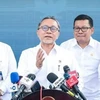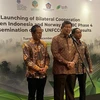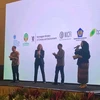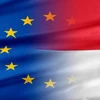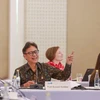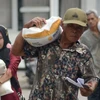The High Representative of the European Union for Foreign Affairs and Security Policy, Federica Mogherini, and the European Commission have adopted the joint communication “The EU and ASEAN: a partnership with a strategic purpose”, which aims to take bilateral ties to the next level.
“The partnership between the EU and ASEAN is crucial and we are determined to build on it and strengthen our political and economic cooperation. From trade to security, from climate change to the rule of law, we have a deep cooperation and as the EU we are supporting ASEAN integration,” Mogherini said. “Deepening and broadening our relations with ASEAN is key for the EU’s Asia strategy”.
In the joint communication, the EU makes the case for taking trade relations with ASEAN to a higher level by working towards a region-to-region free trade agreement, while speeding up connectivity by exchanging experiences and mobilising financial resources and expertise to support ASEAN efforts, such as on the single market and the civil aviation agreement negotiations.
The union also commits to intensifying cooperation on climate change, initiating a new EU-ASEAN policy dialogue on the environment and sustainable development, and doubling financial support to more than 2 billion EUR for ASEAN member states.
Additionally, the EU will also implement a package of initiatives in the field of non-traditional security, including maritime security, disaster management and crisis response, and transnational crime.
The EU and the Association of Southeast Asian Nations (ASEAN) established relations in 1972. In October 2014, they met for an informal Leaders’ Meeting for the first time since 2007. A new EU Ambassador to ASEAN will take up office in Jakarta, Indonesia in September 2015.
The EU is ASEAN’s second largest trade partner now, with bilateral trade exceeding 238 billion EUR in 2013. It is also the biggest provider of FDI in ASEAN, accounting for 22 percent of total FDI in 2013.
The EU is a major development partner for ASEAN and the biggest donor to the ASEAN Secretariat. In the 2014-2020 budget cycle, the EU will provide 170 million EUR for ASEAN integration and the Secretariat, more than double the 70 million EUR donated in the previous cycle (2007-2013).
The two sides have worked together to enhance crisis response and disaster management. Most recently, they organised the second high-level dialogue on maritime security cooperation in Kuala Lumpur, Malaysia in order to exchange experience on integrated and cooperative approaches to maritime issues, such as inter-agency cooperation, transnational crime and port security.-VNA
“The partnership between the EU and ASEAN is crucial and we are determined to build on it and strengthen our political and economic cooperation. From trade to security, from climate change to the rule of law, we have a deep cooperation and as the EU we are supporting ASEAN integration,” Mogherini said. “Deepening and broadening our relations with ASEAN is key for the EU’s Asia strategy”.
In the joint communication, the EU makes the case for taking trade relations with ASEAN to a higher level by working towards a region-to-region free trade agreement, while speeding up connectivity by exchanging experiences and mobilising financial resources and expertise to support ASEAN efforts, such as on the single market and the civil aviation agreement negotiations.
The union also commits to intensifying cooperation on climate change, initiating a new EU-ASEAN policy dialogue on the environment and sustainable development, and doubling financial support to more than 2 billion EUR for ASEAN member states.
Additionally, the EU will also implement a package of initiatives in the field of non-traditional security, including maritime security, disaster management and crisis response, and transnational crime.
The EU and the Association of Southeast Asian Nations (ASEAN) established relations in 1972. In October 2014, they met for an informal Leaders’ Meeting for the first time since 2007. A new EU Ambassador to ASEAN will take up office in Jakarta, Indonesia in September 2015.
The EU is ASEAN’s second largest trade partner now, with bilateral trade exceeding 238 billion EUR in 2013. It is also the biggest provider of FDI in ASEAN, accounting for 22 percent of total FDI in 2013.
The EU is a major development partner for ASEAN and the biggest donor to the ASEAN Secretariat. In the 2014-2020 budget cycle, the EU will provide 170 million EUR for ASEAN integration and the Secretariat, more than double the 70 million EUR donated in the previous cycle (2007-2013).
The two sides have worked together to enhance crisis response and disaster management. Most recently, they organised the second high-level dialogue on maritime security cooperation in Kuala Lumpur, Malaysia in order to exchange experience on integrated and cooperative approaches to maritime issues, such as inter-agency cooperation, transnational crime and port security.-VNA


